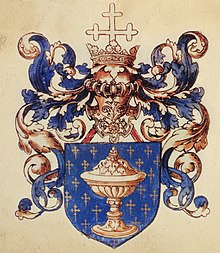Kingdom of Galicia
Kingdom of Galicia Reino de Galicia or Galiza (in Galician) Reino de Galicia (in Spanish) Reino da Galiza (in Portuguese) Galliciense Regnum (in Latin) | |||||||||||||||
|---|---|---|---|---|---|---|---|---|---|---|---|---|---|---|---|
| 910–1833 | |||||||||||||||
| Motto: Hoc hic misterium fidei firmiter profitemur "Here is the mystery of faith that we strongly profess" | |||||||||||||||
| Anthem: Antiga Marcha do Reino de Galicia | |||||||||||||||
 The location of the Kingdom of Galicia in the 11th century CE, in red | |||||||||||||||
| Capital | Santiago de Compostela1 | ||||||||||||||
| Common languages | Latin Vulgar Latin Galician-Portuguese Castilian A few speakers of Brittonic, Visigothic, Vandalic and Suebic | ||||||||||||||
| Religion | Roman Catholicism | ||||||||||||||
| Demonym(s) | Galician | ||||||||||||||
| Government | Monarchy | ||||||||||||||
| Monarch | |||||||||||||||
• 409–438 | Hermeric (first) | ||||||||||||||
• 1813–1833 | Ferdinand VII (last) | ||||||||||||||
| Legislature | Junta | ||||||||||||||
| History | |||||||||||||||
• Founded by García II | 910 | ||||||||||||||
• Dissolved | 1833 | ||||||||||||||
| |||||||||||||||
The Kingdom of Galicia (Galician: Reino de Galicia, or Galiza; Spanish: Reino de Galicia; Portuguese: Reino da Galiza; Latin: Galliciense Regnum) was a political entity (a state) in southwestern Europe, in a region that today includes parts of northern Portugal and northwestern Spain.
History
[change | change source]
Galicia was first part of the Roman province of Gallaecia and it became a kingdom under the Germanic Suebi in the 5th century, and later, from 585 to 711, it was integrated into the Kingdom of the Visigoths.
In the 8th century Galicia became a part of the newly founded Christian kingdoms of the northwest of the peninsula, sometimes called Galicia or derivates,[1] and others Asturias and León. Sometimes it got independence under its own kings.[2] Rulers were titled as "Kings of Galicia" even when they governed from cities like Oviedo or León. This has led to significant historiographical controversy.[3]
Compostela became capital of Galicia in the 11th century. The independence of Portugal (1128) made its southern boundary. The accession of the Castilian King Ferdinand III to the Leonese kingdom in 1230 brought Galicia under the control of the Crown of Castile. The kingdom of Galicia was now a political division in the larger realm, but it continued to maintain a distinct cultural identity.
Related pages
[change | change source]- Galicia (Spain)
- Galician language
- Galician-Portuguese
- Kingdom of Galicia in historiography
- Umayyad conquest of Hispania
- Kingdom of Portugal
References
[change | change source]- ↑ Many ancient and medieval documents consistently refer to the region as Gallaecia or its derivatives such as Gallizia, Gallitia, Galizuland, Yilliqiyya, Jalikia, etc. but translated into "Asturias" or "Leon", as explained in Kingdom of Galicia in historiography.
- ↑ Rodríguez Fernández, Justiniano (1997). García I, Ordoño II, Fruela II, Alfonso IV. Burgos: Editorial La Olmeda. ISBN 84-920046-8-1.
- ↑ As a result, the legacy of the Kingdom of Galicia and its rulers is often contested in academic circles.
External links
[change | change source]- Culture and Society in Medieval Galicia. A Cultural Crossroads at the Edge of Europe James D'Emilio. University of South Florida


